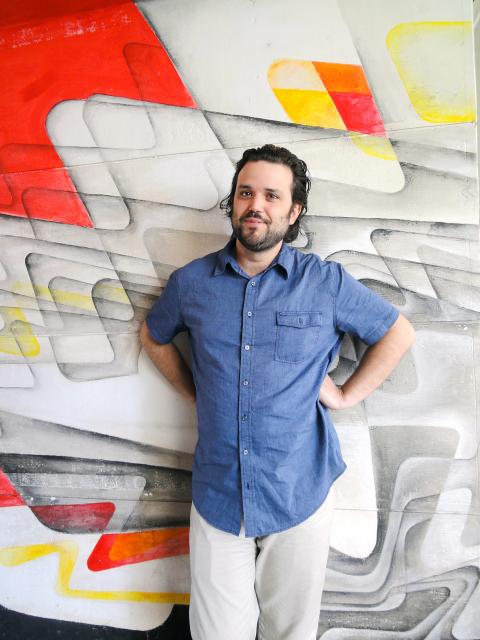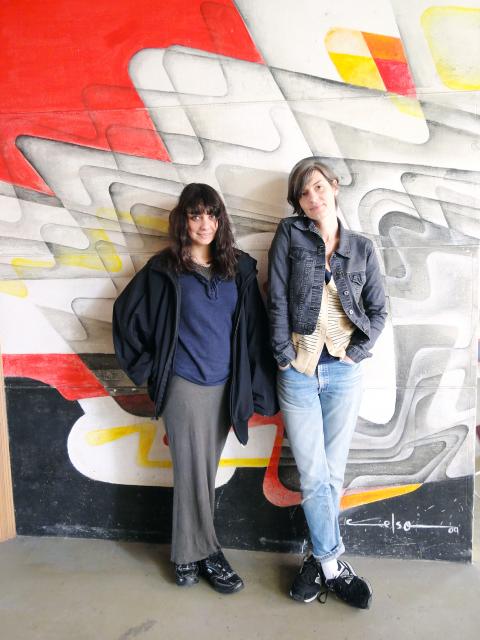The lineup for this year’s edition of Urban Nomad Film Festival’s annual party, which starts tomorrow at 9pm, reflects the event’s growing stature as the country’s most prominent indie cinema showcase.
Headlining the Video Mindfuck Party are video artist Danny Perez, whose Oddsac, a “visual album” he created with experimental rock band Animal Collective, opened the festival yesterday, and Brooklyn-based art-noise band I.U.D., composed of Lizzi Bougatsos, lead singer and founding member of Gang Gang Dance, and Sadie Laska of Growing.
This is their first collaborative project, and the resulting performance, titled Blunt Force Trauma, straddles the boundaries that separate music concert, art installation and theater.

Photo Courtesy of Urban Nomad
The evening begins with electronica/rock group Unfamiliar Friends Party (不熟的朋友派對), followed by 45 minutes of short films.
After Blunt Force Trauma at 10:45pm, expat funk rock band Point 22 (.22) performs at 11:45pm, and then DJs take over, including a set by Perez.
In an interview on Saturday at Taipei Artist Village, I.U.D. and Perez explained how the project came about, why they are dedicated to breaking boundaries and what’s wrong with mediocrity.

Photo Courtesy of Urban Nomad
Taipei Times: How did you hook up?
Sadie Laska: We’ve known Danny for a long time. He worked for Black Dice, and my boyfriend’s in Black Dice. When we made our record The Proper Sex he was a big supporter of it. We started talking a couple of years ago about making a video together, or doing something like this together. So when he got the invitation to come here, he was like, “We should do it.”
TT: Oddsac is described as a “visual album,” with the visual element and the music made simultaneously. Did you work in a similar way?

Photo Courtesy of Urban Nomad
Lizzi Bougatsos: Yeah. We bounced images back and forth. It was a dialogue of imagery and sound that created the concept of what we’re going to do together. I almost see it as like us being characters in a film that Danny’s making, but it’ll be live.
Laska: He sent me some sound clips and then I processed those and put them on a sampler that he’s gonna play, we’re gonna plug him in. He’s gonna play with us. Because our music has a lot of loops and samples, so the visuals are like one more part of that. It isn’t just I.U.D. with visuals behind it.
TT: This is the first time you’ve done this show. What can the audience expect?

Photo Courtesy of Urban Nomad
Laska: We have some masks that Danny made for us to wear. We have some props. We have contact mics, which we haven’t used before. This whole thing is an experiment. And it’s live.
Bougatsos: It’s like improv.
TT: What other elements of the performance are there?

Photo Courtesy of Urban Nomad
Bougatsos: We’ve got two drum kits. We have some stage setting, and we have a fire pit. And chains. And the contact mics, so that our actions will be connected to the sounds. So that’s another way the visuals will be connecting with our sound.
Laska: We were working on having a paper screen, on which to project the visuals, and then rip it open. A lot of this is gonna happen when we set up. We have these elements, and bags full of tricks, and we’ll put it together depending on the space. Danny’s gonna have five projectors. So he’s gonna have his own element while we’re playing. It’s as much a part of it as the music. There’s gonna be moments where that’s the focal point, and we’ll be coming in and out.
Bougatsos: It’s like a happening. It’s like Vienna Actionism. They were so brutal visually.
Laska: That’s an influence of ours. Gunter Brus and Otto Muhl, he did a lot with music. Performances where they cut open live calfs, and there’s blood. Obviously we’re not gonna do that here.
TT: What about the visuals?
Perez: There’s a general sex-positive vibe in I.U.D., as far as the lyrics and the attitude; that’s something I’ve really responded to. You’re gonna see a lot of sexual deviation and weird perversions, and not for shock value, it’s juxtaposed with other images to make a new context. With the music and the costumes and some guy sucking on a dildo in the corner, it’s going to be a pretty immersive experience. It’s notions of sexuality and blunt abrasiveness with these ladies that I respond to. It’s a similar sensibility. It’s a new area to explore. If I’m doing visuals for [founding member of Animal Collective] Panda Bear, then I’m not going to show a woman with three tits and a crazy mask. But with I.U.D. I can get away with that.
Bougatsos: It’s encouraged.
TT: You draw inspiration from pornography and horror movies. Why?
Bougatsos: I think the thing about horror movies is that they have this strange pornographic element. All the things that we find humorous sort of touch on porn. It goes back to when I met Sadie when I was studying sexuality at university. There was much less crime and much less rape. And much less anger towards women when it was in the open and prostitution was actually available. It’s like prohibition, when you hide alcohol, or when you try and stop abortion, more people die, because people are doing abortions at home in the bathtub. It’s like sexuality, when it’s open it’s much more understood that’s it’s human nature, and it’s more accepted.
Laska: Something we’re playing around with is the way women act in rock ’n’ roll. Like women being in a band, and we’re trying to break those conventions, break those boundaries, because they tend to be very sexist.
Bougatsos: When we started playing live shows, sound guys who’d do sound for people like Madonna, Bruce Springsteen, would see my drum set up and be like, “Oh, who do think you are?”
Laska: There’d be this macho thing. We do things differently. I used to have a mic on my snare drum, and I’d rest it on the drum, I thought it sounded best like that. And every time we did a show, the sound guy would be, “You can’t do that. Do you know what you’re doing? These girls don’t know what they’re doing.”
Bougatsos: But after the show they’d love us.
TT: What about criticism?
Laska: Pitchfork hated our record. They just didn’t understand it at all and said the album was what you’d expect from a side project. Like it wasn’t given the attention of our other projects. I thought of it [The Proper Sex] as extreme. And when you make things that are extreme, in any sense, you alienate people who like mediocrity. You know if they don’t like really loud, pounding drums, they’re gonna hate our record. That’s fine. I felt we didn’t really belong on Pitchfork, that wasn’t really the place for a review. We’re not trying to be part of that world.
Bougatsos: I didn’t mind Pitchfork seeing our record. What did we get, like 6.5?
Laska: A two.
Perez: That’s obscene.
TT: Danny, you’ve been doing the festival circuit, what’s the reaction been like to Oddsac?
Perez: It’s been similar to the music I like. The music I like is pretty extreme. I like stuff like I.U.D. I like Throbbing Gristle, but also 1960s saccharine pop. Everything I like, the movies I like, people either love it or hate it, and that’s kind of the reception to Oddsac. I appreciate it. If someone hates it, I guarantee you it’s gonna stick in their head longer than something they kind of liked, which they’ll forget about two weeks later. But two years later they’re gonna be like “I hated that movie,” but they’re still thinking about it. These are fucking crazy times we’re living in, why settle for mediocrity?
Laska: And there’s a lot of mediocrity. A ton of it.
Bougatsos: There’s no censorship of what’s happening in music. There’s just too much of it. People are doing the same thing that other bands done 10 years ago.
Perez: Technology, while being good, is a utilitarian type thing. Kids can now make movies on their laptops, a kid can make an album with a sampler, that’s really cool, but it’s also created a glut of garbage because everyone thinks they can make a movie, everyone thinks they can make an album. That’s the bad aspect. But the good aspect is it’s destroyed a lot of paradigms. Music studios, labels, all that shit is changing. In my head, those motherfuckers have been making a living off mediocrity for the past 30 years, so it’s time to get outta here.
This interview has been edited and condensed.

That US assistance was a model for Taiwan’s spectacular development success was early recognized by policymakers and analysts. In a report to the US Congress for the fiscal year 1962, former President John F. Kennedy noted Taiwan’s “rapid economic growth,” was “producing a substantial net gain in living.” Kennedy had a stake in Taiwan’s achievements and the US’ official development assistance (ODA) in general: In September 1961, his entreaty to make the 1960s a “decade of development,” and an accompanying proposal for dedicated legislation to this end, had been formalized by congressional passage of the Foreign Assistance Act. Two

Despite the intense sunshine, we were hardly breaking a sweat as we cruised along the flat, dedicated bike lane, well protected from the heat by a canopy of trees. The electric assist on the bikes likely made a difference, too. Far removed from the bustle and noise of the Taichung traffic, we admired the serene rural scenery, making our way over rivers, alongside rice paddies and through pear orchards. Our route for the day covered two bike paths that connect in Fengyuan District (豐原) and are best done together. The Hou-Feng Bike Path (后豐鐵馬道) runs southward from Houli District (后里) while the

The Taipei Times last week reported that the Control Yuan said it had been “left with no choice” but to ask the Constitutional Court to rule on the constitutionality of the central government budget, which left it without a budget. Lost in the outrage over the cuts to defense and to the Constitutional Court were the cuts to the Control Yuan, whose operating budget was slashed by 96 percent. It is unable even to pay its utility bills, and in the press conference it convened on the issue, said that its department directors were paying out of pocket for gasoline

On March 13 President William Lai (賴清德) gave a national security speech noting the 20th year since the passing of China’s Anti-Secession Law (反分裂國家法) in March 2005 that laid the legal groundwork for an invasion of Taiwan. That law, and other subsequent ones, are merely political theater created by the Chinese Communist Party (CCP) to have something to point to so they can claim “we have to do it, it is the law.” The president’s speech was somber and said: “By its actions, China already satisfies the definition of a ‘foreign hostile force’ as provided in the Anti-Infiltration Act, which unlike